|
|
Star Drilling Machine
The portable rigs of the Star Drilling Machine Company of Akron, Ohio, date to the 1890's. They enjoyed a wide popularity and apparently fulfilled the boasts of the manufacturer, of which there were many. "Ninety-five percent of all oil wells in the world drilled by portable machines were drilled by Star Drilling Machines." Quoting a Star bulletin, the factory at Akron was said by the company to be "The largest factory in the world manufacturing only Portable Drilling Machines." "Full portability and high efficiency have made the name 'Star' a byword for drilling economy the world over." The company laid out seven "claims of superiority". These claims covered everything from the wagon to the mast and all of the parts in-between. The "standard of perfection" was achieved in their view.
The Star was certainly held in high regard in the 1900's until after WW II when the company ceased to manufacture. Star started out with steam powered rigs, some capable of traction, and ended up with gasoline-powered truck-mounted machines as well as tractor drive machines. They called the latter the "super-tractor model".
Older, retired (and not retired) oilmen whom I have talked to in the Venango County oilfields, Pennsylvania, seem to be divided into two main groups as far as their preferences for drilling machines are concerned. There is the Wolfe machine crowd and the Star bunch, with a few favoring other makes which they probably inherited or had seen their fathers or grandfathers use. The preference for one make or the other must have been handed down. The fact that most of the classic machines haven't been made for many decades doesn't diminish the memory of these oilmen. And they could keep a Star running forever by cannibalizing parts from abandoned Stars out in the woods.
A particularly favored machine of the early 1900's (and teens) was the Star No. 2 Portable Drilling machine. It was also known as the "800 foot machine". A separate boiler and vertical steam engine served to work it. The wheel-mounted machine was hauled to the well location by a team of horses until tractors became available. Star also made a traction version of this machine with a T-boiler and steam engine mounted directly on the wagon. It had a top speed of 3 MPH and a "cruising speed" of 1.5 MPH depending on the terrain.
As the cost of fuel and scarcity of water became problems for steam rigs in some arid areas, Star came up with portable drilling rigs powered by gasoline which were put into general use in the 1920's. Steam machines already at work could be easily converted to gasoline according to a Star bulletin.
The Star gasoline powered units such as their "E" type machines had a Hercules 90 HP engine mounted on the machine frame. Other models had 45 HP. A Star Natural Gas Attachment allowed changing from one fuel to the other by simply closing one fuel line and opening the other. Star also had an electric power unit for drilling.
Ready for any contingency, Star developed models in the 1920's - 30's (even into the 1940's) on which the gasoline engine did only the drilling, another model on which the engine also did the moving, and a model which used a separate prime mover. Tractor spudding machines with the tracks at the engine end of the frame (rear) were available to the oilfields. The Hercules engines were then built to 98, 113 and 150 HP sizes. Star advertised their Lease Maintenance Machines which came in different models such as the K type (2000 foot) which was powered by a separate tractor or skid-mounted engine. Another model, the 44ST (3000 foot) was truck-mounted. Lease maintenance was a way of saying that the outfit was capable of cleaning out, bailing, pulling wells, deepening wells and even for new drilling in shallow territory.
Star advertised various models for light drilling which was mostly water well work. Such machines had capabilities to 150-300 feet.
Abandoned Star rigs (or what are sworn to be Star) are still out there in the Pennsylvania oilfields. There are perhaps more of this make than any other. The author remembers ads in the newspaper classified section mentioning Star rigs for sale. They sold, but I don't know where they are now. Perhaps in use or prettied up for show?
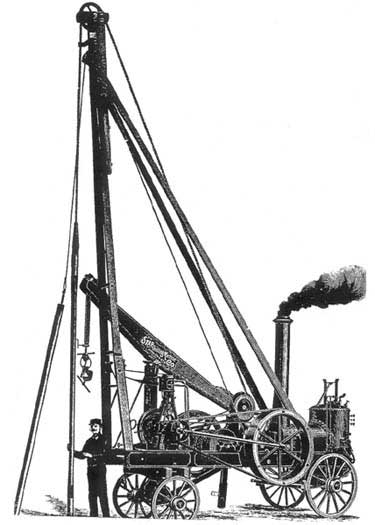 |
The Star No. 2 drilling machine was a very popular model in the shallow oilfields in the early 1900's and teens. It had a rated capacity of 800 feet but probably would drill or clean a little deeper. The machine as shown was self-propelled.
Operators often chose a model without the mounted vertical steam engine and T-boiler (or stripped them off), preferring to use separate power plants and changing when needed, i.e. steam to gas or gasoline, even electricity. In 1910, 20, and into the 30's all types of power plants were introduced to the oilfields. A lot of operators hauled their rigs rather than use the traction of the No. 2 machine type which needed assistance in the rugged topography anyway. Cut is from an early Star Drilling Machine Co. handbook.
|
|
| |
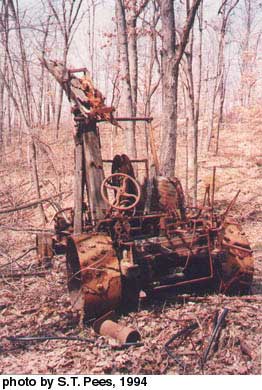 |
This is a Star No. 2 Portable Drilling Machine abandoned in a ravine. A barely surviving piece of the wood walking beam still attempts to strike a jaunty angle. This No. 2 machine saw some really rough oilfield work. Originally a vertical steam engine was mounted on the machine, but the boiler was mounted separately on wheels and hauled to the location. The operator changed his equipment over to Buffalo vertical gas engines after 1920 (D. Weber, written communication).
|
|
| |
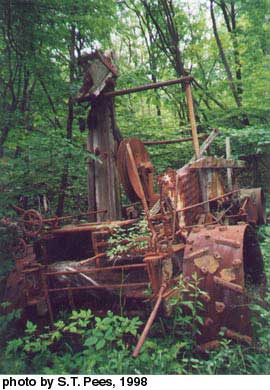 |
This is the same Star rig shown in the previous photograph. When the forest is in leaf old artifacts are partly hidden.
|
|
| |
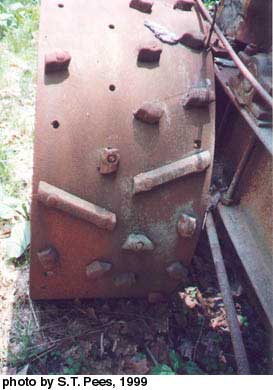 |
This photograph showing what is left of the cleats on a steel wheel of the previously mentioned Star No. 2 machine attests to the difficulties encountered while moving the rig to the well locations. Most have broken off. Also shown is a portion of the steel frame of the wagon.
|
|
| |
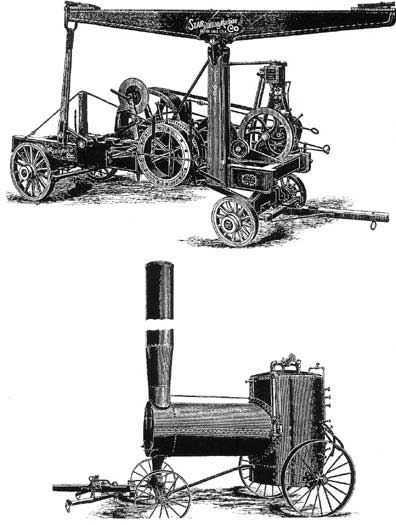 |
This is a Star No. 7, or 2500 foot drilling machine. The vertical steam engine is mounted on the rig. The rig and the T-boiler, both having wagon poles, were hauled to the well location by teams of horses. Circa 1910. Cut is from an early Star Drilling Machine Co. handbook.
|
|
| |
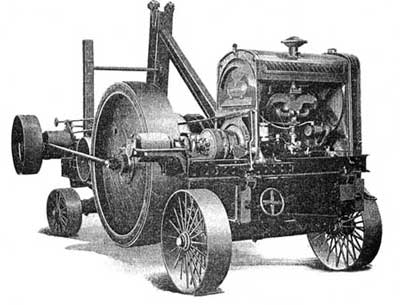 |
Star "E" type machine as shown in 1928 Star Bulletin No. 17. The engine is a 90 HP four cylinder Hercules and was used only for drilling. This model was not self-propelled. It probably superseded the older Star No. 7.
|
|
| |
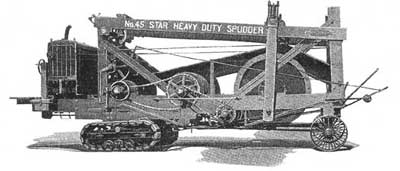 |
This Star Heavy Duty Spudder (#45) had a capacity of 2000-2500 feet. Star comments that "approximately 75% of the trucking, tearing down and rigging up expense of a standard rig or semi-portable outfit is saved". From Star Bulletin No. 49A.
|
|
| |
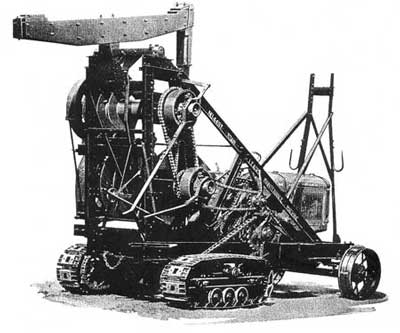 |
This picture is a No. 44ST for lease maintenance work to 3000-3500 feet. A McCormick-Deering tractor unit is built into the machine. From a Star bulletin.
|
|
| |
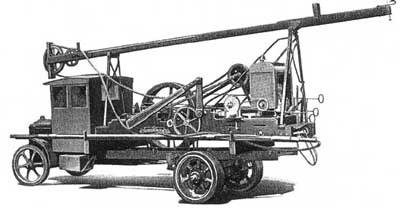 |
In addition to the Hercules engines already mentioned, Star used LeRoi 4 cylinder engines on two models. This drawing shows what a truck-mounted LeRoi gasoline engine rig looked like. The model was No. 32A used principally for drilling water wells. Cut is from Bulletin No. 25.
|
|
| |
 |
This model 42ST is a heavy duty spudder, also called a Star Super-Tractor. It is the smallest of the heavy duty spudders, having a rated drilling capacity of 1000-1500 feet. It weighed 21,400 lbs. with mast. From a Star publication.
|
|
| |
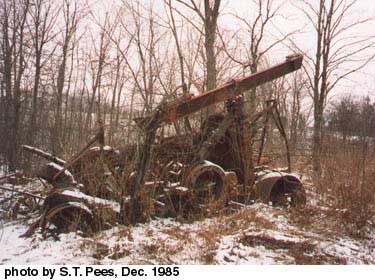 |
Said by local residents to be a portable Star rig, age unknown. The walking beam is steel.
|
|
| |
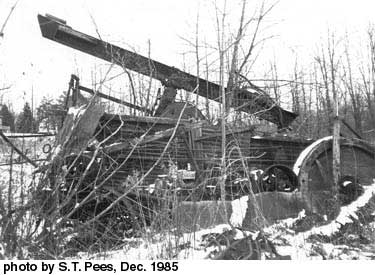 |
View of the other side of the same Star rig pictured above. The band wheel is at the right. Levers and wheels are obscured in the brush.
|
|
| |
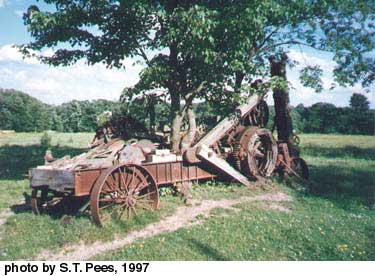 |
Here rests the hopes of a farmer-oilman who bought this Star rig second hand (maybe third or fourth) and brought it to this pasture on his farm to drill for oil. The drilling plans were put off for awhile. Now trees grow up through the machinery.
|
|
|

![]()












